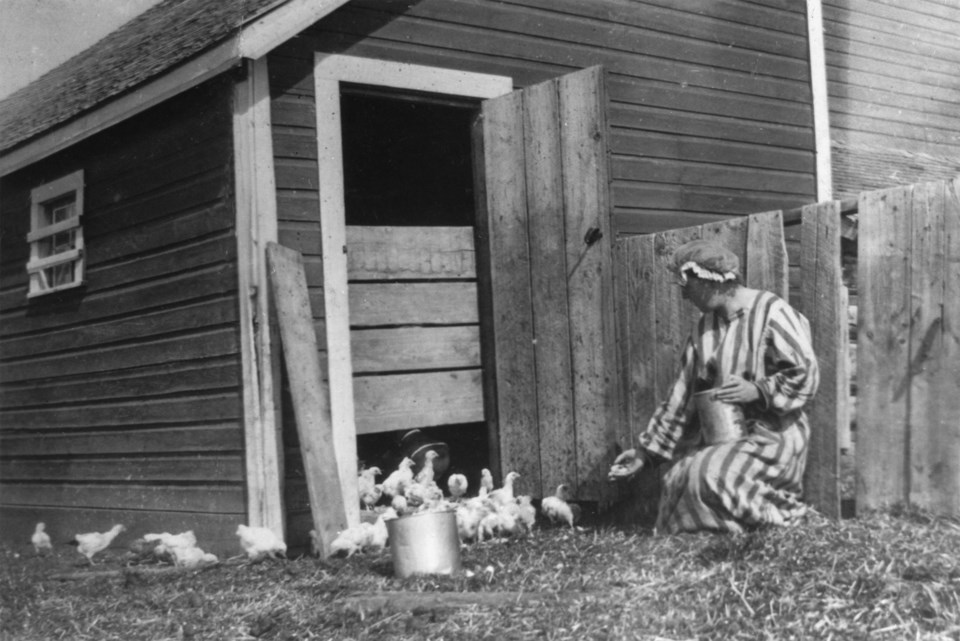Up until recently, St. Albert’s early settlement era was defined by men. A new exhibit at Musée Heritage Museum showcases the little-known hardships women faced and how their resilience built a strong community.
A Woman’s Place: How the strength of women laid the foundation for a city features major contributions of women from the time of the fur trade to the mid 20th century. The name says it all — it features women who lived daily lives nurturing their families and establishing a thriving community.
The exhibit reveals that not only did women cook, clean and wash dirty laundry. In addition to managing families, they ran businesses all the while supporting each other through privations unimaginable to us today.
“This is about real women — the mums who lost their husbands and had a family to feed. It’s about women stepping up during wars and the Depression. It’s about women who stepped up and learned from each other. For example, we have a Childbirth section where Indigenous and Métis women were often the midwives offering major support to settlers who had just arrived,” said curator Joanne White.
Through a series of 34 black and white photographs, panels and artifacts, A Woman’s Place showcases their strong, tenacious spirit, and valuable contributions and perspectives made while facing discrimination from the church and politicians.
One panel describes women advocating to obtain the vote prior to the First World War and St. Albert's sheepish role. After 40 years of the women’s suffrage movement demanding parity with men, the only member of the legislature to oppose the second reading was St. Albert’s former mayor, Lucien Boudreau.
It was 1916 and an Edmonton newspaper gave an account of Boudreau’s reasoning for his opposition.
The article read, “Lucien Boudreau of St. Albert could not support the bill, and argued that the place of women was in the home... He asserted that many women had signed the petition without knowing what it was about... He hoped although they were going to get the franchise, that the women would do the best they could for its welfare, without meddling in the public affairs of the province.”
White added that many European settlers were unprepared to survive without the assistance of First Nations and Métis. She acknowledges the Indigenous population deserves a great deal of gratitude for sharing their knowledge and saving lives.
“Settlers needed to learn what was here. Medicines at the time were herbal, chemical or plant-based. There weren’t any drug stores around and they needed to learn the remedies that were special to the region. They needed to be educated in the local knowledge whether it was hunting, building shelters, medicine or childbirth."
First Nations women were similar to women across the world raising families, maintaining a home, supporting their husbands and community. Through the photos and artifacts, women are seen drying meat and cleaning hides, gathering fuel, cooking, making clothing and snowshoes as well as displaying their artistic talents in forms of decoration.
Although there was resistance to women in politics, tough businesswomen thrived when people realized the valuable contributions of the female persuasion. For instance, Mrs. Marie Asselin ran the St. Albert Hotel while Mrs. Emma Bagley operated St. Albert’s dance and community hall.
The town blacksmith Joseph Leonard took over the post office, but it was his daughters Rosa and Amanda who ran it from their home for 12 years. Mrs. Anna Mauchle acquired the telephone exchange in 1911 and ran it from her home for decades. She spoke French, English and Cree. Her husband, Jacob, spoke German. Together they were able to translate any call that came through.
Mrs. Norah Donlevy reached the remarkable status of town council secretary-treasurer in 1922 receiving $720 per year. At the time average men’s wage in manufacturing was $900 per year while women working as farm help earned $400 per year.
White has known many of these women’s stories for a long time, and through this exhibit she wants to provide a frame of reference for their contributions.
“We need to remember women now are very comfortable and fortunate. We need to remember the incredible hard work that went into building our community. And none of that would have happened if women weren’t working together and working non-stop.”
A Woman’s Place is featured at Musée Heritage Museum, St. Albert Place, 5 St. Anne Street, until March 23, 2023.




